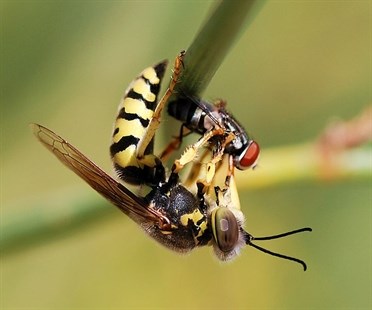
Image Credit: Wikipedia
September 03, 2013 - 8:23 PM
THOMPSON-OKANAGAN - Those pesky uninvited guests at your barbeque dinner are looking for their last free meals of the summer.
An influx in wasp activity this year could be partly due to a milder than usual winter increasing the survival rate of dormant queens. Royal B.C. Museum entomologist Claudia Copley says it's not until late summer that we typically notice the insects dropping in at our picnics and barbeques.
"The colonies are starting to break down, the queen is beginning to die and the workers are doomed," Copley says, which means they're in survival mode and foraging for protein before the cooler fall season hits.
Enviro Pro Pest Control general manager Mark Dawson says the insects are keeping them busy.
"It wasn't this bad last year," he says, adding their pest control service has been responding to complaints since mid July.
In their search for protein, foraging wasps tend to find their way to sweet smelling foods — patio barbeques being the number one attractant. While they're a nuisance, Dawson says they pose little threat and are more likely eyeing your steak dinner than your flesh.
"When they sting, they're defensive," he says. “You generally aren't getting attacked unless you disturb the nest.”
The best thing to do is gently brush them away or use a wasp catcher to tempt them elsewhere. Catchers available in stores and through pest control come equipped with a water bag and pheromones that attract wasps.
"If you're on your deck barbeque, for example, you can draw them away with a catcher," Dawson says, though they need to be replaced every four to five days. Alternatively, you can craft your own catcher using a sugary drink or soda.
Copley agrees. Anything "sweet or meat" is sure to attract attraction, she says.
"Even if you've just eaten a peach," the wasps are intelligent enough to detect the scent of the fruit's sugars.
The best way to kill the buzz?
Clean your barbeque and don't leave food out.
It's particularly difficult to trace foraging wasps to their nests, but if you do find a nest it's best to call a professional.
Typical nesting areas
Right now, typical nesting spots are underneath juniper trees, piled needles or underbrush as well as the ceilings of manmade structures.
"Underneath the shingles on your roof, decks or railings, there are little pockets where wasps can usually start building nests," Dawson says.
Come fall, wasps die off and their nests go dormant. Simply removing a dormant nest isn't enough, guided by scent the wasps will rebuild the same nest the following year.
"You have to clean it out thoroughly," Dawson says and for that they use dusts and residual chemicals to break down the colony.
Despite the complaints, Copley says the label 'pest' isn't entirely fitting.
"Wasps are really beneficial - they hunt in our gardens eating problem insects," she says, and we should be prepared to tolerate them a bit longer if the warm weather holds up. It could be another month before they begin to die off.
"The hives still seem to be functioning, the queen is still there," she says. Not until the queens leave their nest will the colonies dissipate and the wasps slowly disappear from our dinner tables.
To contact the reporter for this story, email Julie Whittet at jwhittet@infotelnews.ca or call (250)718-0428.
News from © iNFOnews, 2013